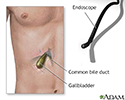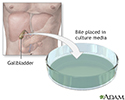Biopsy - biliary tract
Cytology analysis - biliary tract; Biliary tract biopsyA biliary tract biopsy is the removal of small amounts of cells and fluids from the duodenum, bile ducts, pancreas, or pancreatic duct. The sample is examined under a microscope.
Biopsy
A biopsy is the removal of a small piece of tissue for lab examination.

How the Test is Performed
A sample for a biliary tract biopsy can be obtained in different ways.
A needle biopsy can be done if you have a well-defined tumor.
- The biopsy site is cleaned.
- A thin needle is inserted into the area to be tested, and a sample of cells and fluid are removed.
- The needle is then removed.
- Pressure is put on the area to stop any bleeding. The site will be covered with a bandage.
If you have a narrowing or blockage of the bile or pancreatic ducts, a sample can be taken during procedures such as:
-
Endoscopic retrograde cholangiopancreatography (ERCP)
Endoscopic retrograde cholangiopancreat...
ERCP is short for endoscopic retrograde cholangiopancreatography. It is a procedure that looks at the bile and pancreatic ducts. It is done through...
 ImageRead Article Now Book Mark Article
ImageRead Article Now Book Mark Article -
Percutaneous transhepatic cholangiogram (PTCA)
Percutaneous transhepatic cholangiogram...
A percutaneous transhepatic cholangiogram (PTC) is an x-ray of the bile ducts. These are the tubes that carry bile from the liver to the gallbladder...
 ImageRead Article Now Book Mark Article
ImageRead Article Now Book Mark Article - Endoscopic ultrasound (EUS)
How to Prepare for the Test
You may not be able to eat or drink 8 to 12 hours or more before the test. Your health care provider will tell you ahead of time what you need to do.
Make sure you have someone to drive you home. For some of these tests, you will have sedation. If you have sedation, you shouldn't drive, operate machinery, or make legal decisions for 24 hours after.
How the Test will Feel
How the test will feel depends on the type of procedure used to remove the biopsy sample. With a needle biopsy, you may feel a sting as the needle is inserted. Some people feel a cramping or pinching feeling during the procedure.
Medicines that stop pain and help you relax are commonly used for biliary tract biopsy procedures.
Why the Test is Performed
A biliary tract biopsy can determine if a tumor started in the liver or spread from another location. It also can determine if the tumor is cancerous.
This test may be done:
- After a physical exam, x-ray, MRI, CT scan, or ultrasound shows abnormal growths in your biliary tract
x-ray
X-rays are a type of electromagnetic radiation, just like visible light. An x-ray machine sends individual x-ray waves through the body. The images...
 ImageRead Article Now Book Mark Article
ImageRead Article Now Book Mark ArticleMRI
A magnetic resonance imaging (MRI) scan is an imaging test that uses powerful magnets and radio waves to create pictures of the body. It does not us...
 ImageRead Article Now Book Mark Article
ImageRead Article Now Book Mark ArticleCT scan
A computed tomography (CT) scan is an imaging method that uses x-rays to create pictures of cross-sections of the body. Related tests include:Abdomin...
 ImageRead Article Now Book Mark Article
ImageRead Article Now Book Mark ArticleUltrasound
Ultrasound uses high-frequency sound waves to make images of organs and structures inside the body.
 ImageRead Article Now Book Mark Article
ImageRead Article Now Book Mark Article - To test for diseases or infection
Normal Results
A normal result means there are no signs of cancer, disease, or infection in the biopsy sample.
What Abnormal Results Mean
Abnormal results may be due to:
- Cancer of the bile ducts (cholangiocarcinoma)
Cholangiocarcinoma
Cholangiocarcinoma (CCA) is a rare cancerous (malignant) growth in one of the ducts that carries bile from the liver to the small intestine.
 ImageRead Article Now Book Mark Article
ImageRead Article Now Book Mark Article -
Cysts in the liver
Cysts
A cyst is a closed pocket or pouch of tissue. It can be filled with air, fluid, pus, or other material.
 ImageRead Article Now Book Mark Article
ImageRead Article Now Book Mark Article -
Liver cancer
Liver cancer
Hepatocellular carcinoma is cancer that starts in the liver.
 ImageRead Article Now Book Mark Article
ImageRead Article Now Book Mark Article -
Pancreatic cancer
Pancreatic cancer
Pancreatic cancer is cancer that starts in the pancreas.
 ImageRead Article Now Book Mark Article
ImageRead Article Now Book Mark Article - Swelling and scarring of the bile ducts (primary sclerosing cholangitis)
Primary sclerosing cholangitis
Sclerosing cholangitis refers to swelling (inflammation), scarring, and destruction of the bile ducts inside and outside of the liver.
 ImageRead Article Now Book Mark Article
ImageRead Article Now Book Mark Article
Risks
Risks depend on how the biopsy sample was taken.
Risks may include:
- Bleeding at the biopsy site
- Infection
- Sedation-related risks, including a drop in blood pressure, heart rate, or breathing
References
Cratchley AL, Rotimi O, Haughk B. Liver, biliary system and pancreas. In: Cross SS, ed. Underwood's Pathology. 8th ed. Philadelphia, PA: Elsevier; 2025:chap 16.
Gibson RN, Sutherland TR. The biliary system. In: Adam A, Dixon AK, Gillard JH, Schaefer-Prokop CM, eds. Grainger & Allison's Diagnostic Radiology. 7th ed. Philadelphia, PA: Elsevier; 2021:chap 24.
Martin P. Approach to the patient with liver disease. In: Goldman L, Cooney KA, eds. Goldman-Cecil Medicine. 27th ed. Philadelphia, PA: Elsevier; 2024:chap 132.
-
Gallbladder endoscopy - illustration
An endoscope, a flexible fiberoptic scope with a light, is inserted through the mouth into the duodenum. A catheter is advanced through the endoscope and inserted into the pancreatic or biliary ducts. A contrast agent is injected into these ducts and X-rays are taken to evaluate their caliber, length and course. Endoscopic retrograde cholangiopancreatography (ERCP) is performed to identify any narrowing, stones, or tumors in the pancreatic or biliary ducts.
Gallbladder endoscopy
illustration
-
Bile culture - illustration
A bile culture test is performed to see if there is infection in the biliary tract. A specimen of bile is placed in culture media and observed for growth of microorganisms. If there is no growth in the culture, then there is no infection. If there is growth in the culture media, the growth is then isolated and identified to determine the appropriate method of treatment.
Bile culture
illustration
-
Gallbladder endoscopy - illustration
An endoscope, a flexible fiberoptic scope with a light, is inserted through the mouth into the duodenum. A catheter is advanced through the endoscope and inserted into the pancreatic or biliary ducts. A contrast agent is injected into these ducts and X-rays are taken to evaluate their caliber, length and course. Endoscopic retrograde cholangiopancreatography (ERCP) is performed to identify any narrowing, stones, or tumors in the pancreatic or biliary ducts.
Gallbladder endoscopy
illustration
-
Bile culture - illustration
A bile culture test is performed to see if there is infection in the biliary tract. A specimen of bile is placed in culture media and observed for growth of microorganisms. If there is no growth in the culture, then there is no infection. If there is growth in the culture media, the growth is then isolated and identified to determine the appropriate method of treatment.
Bile culture
illustration
Review Date: 2/3/2025
Reviewed By: Jenifer K. Lehrer, MD, Gastroenterologist, Philadelphia, PA. Review provided by VeriMed Healthcare Network. Also reviewed by David C. Dugdale, MD, Medical Director, Brenda Conaway, Editorial Director, and the A.D.A.M. Editorial team.



